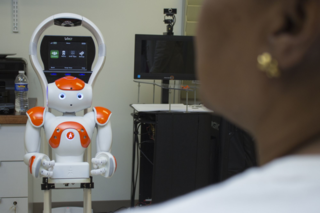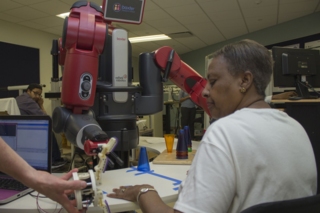Robots cause a polarizing effect in the minds of people. We only have to look to Hollywood to illustrate this. They’re either portrayed as endearing characters like Star Wars’ C-3PO and R2D2 and the adorably-animated WALL-E – or they’re killing machines as seen in Terminator and iRobot.
 The fact is robots are a part of 21st century life, proving in reality they’re more friend than foe. They’re vacuuming floors. They’re working in factories. They’re entertaining millions in theme parks. They’re even in hospital operating rooms. Now, a team of researchers, led by Michelle J. Johnson, PhD, an assistant professor of Physical Medicine and Rehabilitation in Penn’s Perelman School of Medicine, is working to create affordable robotic systems to help patients all over the world with non-traumatic brain injury, such as stroke and cerebral palsy, amputated limbs, and spinal cord injuries.
The fact is robots are a part of 21st century life, proving in reality they’re more friend than foe. They’re vacuuming floors. They’re working in factories. They’re entertaining millions in theme parks. They’re even in hospital operating rooms. Now, a team of researchers, led by Michelle J. Johnson, PhD, an assistant professor of Physical Medicine and Rehabilitation in Penn’s Perelman School of Medicine, is working to create affordable robotic systems to help patients all over the world with non-traumatic brain injury, such as stroke and cerebral palsy, amputated limbs, and spinal cord injuries.
Johnson is the director of Penn’s Rehabilitation Robotics Research & Development Lab located at Penn Medicine Rittenhouse. The Lab is dedicated to “robot-mediated rehabilitation” and focuses on the investigation and rehabilitation of dysfunction due to aging, neural disease, and neural injury. “Our mission is to combine robotics, rehabilitation, and neuroscience techniques to translate research findings into the development of assistive and therapeutic rehabilitation robots, capable of interacting safely with patients in real-world rehab environments,” said Johnson. “Ultimately, the goal is to improve patients’ quality of life and function of performing activities of daily living – such as eating, drinking and grooming – in supervised or under-supervised settings.” (Check out this video to see some of them in action in Penn's Rehab Robotics Lab.)
For example, meet Flo – a mobile service robot named in honor of Johnson’s grandmother, a stroke survivor. The most anthropomorphized of all the current systems Johnson’s team is developing, Flo is a cute, humanoid robot being programmed especially to treat recovering stroke patients with upper body disabilities. Developed for use in hospitals, nursing homes, and other inpatient rehab facilities, Flo is remotely operated by a physician and can interact directly with patients via an attached video screen. Flo greets patients, demonstrates exercises, and spurs more movement by asking the patient to “grab my hand” and “push the button on top of my head.” Flo even offers words of encouragement after each accomplished task. Cooler still, Flo is programmed to offer those words of encouragement in not only English, but also French, Arabic, and Spanish.
Other robots in Johnson’s lab (demonstrated in the video below) can be attached to injured limbs to aid in movement and provide feedback to patients. “Robots can positively aid in a patient’s recovery by working with them to improve range of motion and re-acquire motor skills lost because of stroke,” said Johnson.
 Just a couple of weeks ago, Johnson and her colleagues celebrated the first year anniversary of the Lab, with an open house. During the event, Johnson, along with Roshan Rai, Lab manager and engineer, Nicholas Vivio, clinical research co-coordinator, and about a dozen undergrad and graduate student research assistants gave demonstrations of current robot projects for rehab along with formal presentations. The presentations were grouped in one of three tracks – mobile therapy assistants, neuro-rehabilitation, and global health – and helped further demonstrate for visitors the Lab’s mission to effectively and economically fuse health care and robotics.
Just a couple of weeks ago, Johnson and her colleagues celebrated the first year anniversary of the Lab, with an open house. During the event, Johnson, along with Roshan Rai, Lab manager and engineer, Nicholas Vivio, clinical research co-coordinator, and about a dozen undergrad and graduate student research assistants gave demonstrations of current robot projects for rehab along with formal presentations. The presentations were grouped in one of three tracks – mobile therapy assistants, neuro-rehabilitation, and global health – and helped further demonstrate for visitors the Lab’s mission to effectively and economically fuse health care and robotics.
“A critical aspect of what we’re doing in the lab is designing and developing affordable novel therapy robots to address the need for accessible, low-cost technologies with the potential for national and global applications,” said Johnson. “In the lab, we jokingly refer to it as ‘rehab in a box.’”
Johnson may have been joking, but the phrase is brilliantly applied. Robot-assisted therapy sounds like a good thing. But it's a hi-tech thing, so it must be expensive, right? Not so. Johnson’s lab is working to not recreate the wheel, but use, combine, modify, and expand on existing technologies to create affordable systems that can be deployed in remote areas of the U.S., Mexico, and Africa to start. Systems that could aid where access to health care (let alone the months of rehabilitation needed for neuro-impaired patients) is limited or not available at all. Therapeutic robotic systems constructed not from expensive, one-of-a-kind parts that would have to be custom made and take weeks to replace, but those which may literally one day be boxed up and sent half way around the world.
Back on these shores, others are finding the work from Johnson’s Lab intriguing too: she was just awarded a three-year grant from the National Science Foundation toward the labs work toward affordable and mobile assistive robots for elderly care.
In keeping with their mission to create affordable solutions, the Lab has established a partnership with a Latin America university (ITESM, Instituto Tecnológico y de Estudios Superiores de Monterrey) and is in the process of seeking out opportunities in Africa to do the same. Johnson is currently in Africa, spending eight days of intense networking seeking out collaborators with her lab through the Botswana-UPenn Partnership.
Affordable and Mobile Assistive Robots for Elderly Care